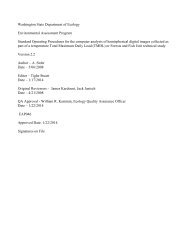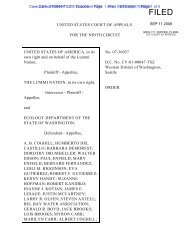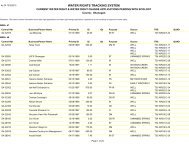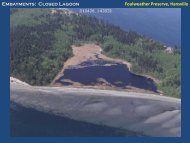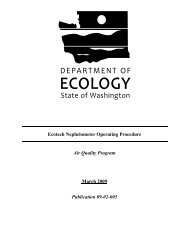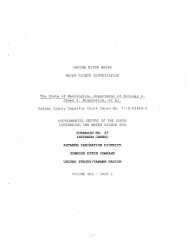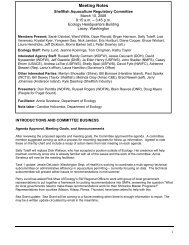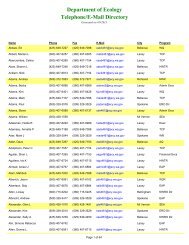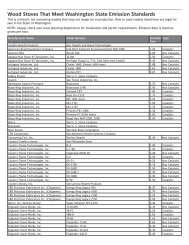General Permit for Biosolids Management - Washington State ...
General Permit for Biosolids Management - Washington State ...
General Permit for Biosolids Management - Washington State ...
Create successful ePaper yourself
Turn your PDF publications into a flip-book with our unique Google optimized e-Paper software.
<strong>General</strong> <strong>Permit</strong> <strong>for</strong> <strong>Biosolids</strong> <strong>Management</strong> Page 5<br />
“Class I biosolids management facility” is any publicly owned treatment works (POTW), as defined in 40<br />
CFR 501.2, required to have an approved pretreatment program under 40 CFR 403.8(a) (including any<br />
POTW located in a state that has elected to assume local program responsibilities under 40 CFR<br />
403.10(e)), and any treatment works treating domestic sewage, as defined in 40 CFR 122.2, classified as<br />
a Class I biosolids management facility by the EPA Regional Administrator, or in the case of approved<br />
state programs, the Regional Administrator in conjunction with the state director, because of the<br />
potential <strong>for</strong> its biosolids use or disposal practice to affect public health and the environment adversely.<br />
“Clean Water Act” or “CWA” means the Clean Water Act or Federal Clean Water Act (FCWA) (<strong>for</strong>merly<br />
referred to as either the Federal Water Pollution Act or the Federal Water Pollution Control Act<br />
Amendments of 1972), Public Law 92-500, as amended by Public Law 95-217, Public Law 95-576, Public<br />
Law 96-483, Public Law 97-117, and Public Law 100-4.<br />
“Complete application” includes but, is not limited, to the following: a completed Application <strong>for</strong><br />
Coverage, a vicinity map of the facility, a vicinity map of any associated treatment or storage facilities, a<br />
treatment facility schematic, confirmation that the SEPA requirements have been met, confirmation<br />
that public notice requirements have been met, land application plans if required, monitoring data if<br />
required, a biosolids sampling plan if required, a contingency plan <strong>for</strong> exceptional quality biosolids if<br />
required, a temporary disposal plan if required, a spill prevention/ response plan if required, and a<br />
signature by an appropriate official.<br />
“Composting” means the biological degradation of organic materials under controlled conditions<br />
designed to promote aerobic decomposition. This does not include the treatment of sewage sludge in a<br />
digester at a wastewater treatment plant.<br />
“Cumulative pollutant loading rate” is the maximum amount of a pollutant that can be applied to an<br />
area of land from biosolids that exceed the pollutant concentration limits established in Table 3 of WAC<br />
173-308-160.<br />
“Density of microorganisms” is the number of microorganisms per unit mass of total solids (dry weight)<br />
in the biosolids.<br />
“Department” means the <strong>Washington</strong> state department of ecology and, within the scope of its<br />
delegation, a local health jurisdiction that has been delegated authority under WAC 173-308-050.<br />
“Director” means the director of the department of ecology or his or her authorized representative.<br />
“Disposal on a long-term basis” means to adopt disposal as a preferred method of management <strong>for</strong> at<br />
least 5 years, or <strong>for</strong> an indefinite period of time with no expectation <strong>for</strong> pursuing other management<br />
alternatives.<br />
“Disposal on a temporary basis” means a period of more than 1 but less than 5 years. <strong>General</strong>ly,<br />
situations requiring the temporary use of disposal facilities will normally occur as a result of deficiencies<br />
in the wastewater or biosolids treatment process, or economic, administrative, or contractual<br />
constraints which cannot be resolved in less than 1 year.<br />
“Disposal on an emergency basis” means a period up to but not exceeding 1 year. <strong>General</strong>ly, emergency<br />
situations requiring the use of disposal facilities will normally occur as a result of inclement weather<br />
conditions at a beneficial use site, contractual or technical difficulties in the treatment, transportation,<br />
or application of the biosolids, or as a result of short term economic or administrative barriers, any and<br />
all of which are expected to be resolved within a period of 1 year.<br />
“Domestic sewage” is waste and wastewater from humans or household operations that is discharged<br />
to or otherwise enters a treatment works.<br />
“Dry weight basis” means calculated on the basis of having been dried at 105 C (221°F) until reaching a<br />
constant mass (in other words, essentially 100% solids content).<br />
“EPA” means the United <strong>State</strong>s Environmental Protection Agency.



